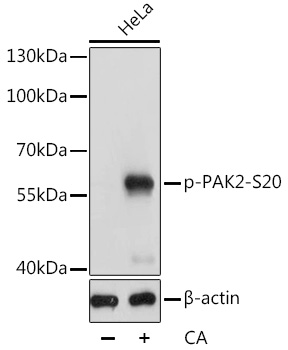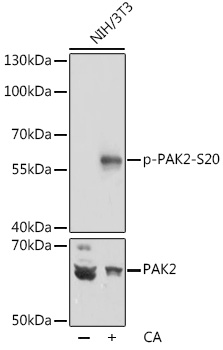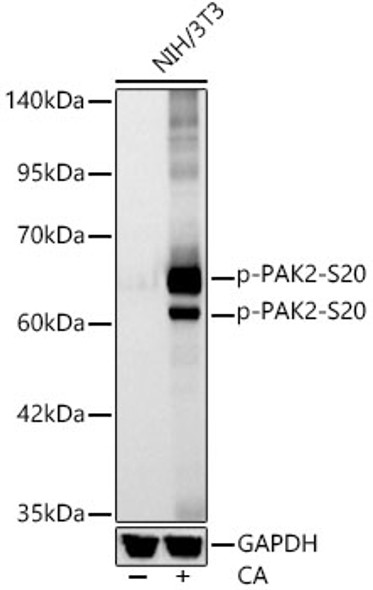Cell Death Antibodies 2
Anti-Phospho-PAK2-S20 pAb Antibody (CABP0803)
- SKU:
- CABP0803
- Product Type:
- Antibody
- Applications:
- WB
- Reactivity:
- Human
- Reactivity:
- Mouse
- Host Species:
- Rabbit
- Isotype:
- IgG
- Research Area:
- Cell Death
Description
| Antibody Name: | Anti-Phospho-PAK2-S20 Antibody |
| Antibody SKU: | CABP0803 |
| Antibody Size: | 20uL, 50uL, 100uL |
| Application: | WB |
| Reactivity: | Human, Mouse |
| Host Species: | Rabbit |
| Immunogen: | A synthetic phosphorylated peptide around S20 of human PAK2 (NP_002568.2). |
| Application: | WB |
| Recommended Dilution: | WB 1:500 - 1:2000 |
| Reactivity: | Human, Mouse |
| Positive Samples: | HeLa, NIH/3T3 |
| Immunogen: | A synthetic phosphorylated peptide around S20 of human PAK2 (NP_002568.2). |
| Purification Method: | Affinity purification |
| Storage Buffer: | Store at -20°C. Avoid freeze / thaw cycles. Buffer: PBS with 0.02% sodium azide, 50% glycerol, pH7.3. |
| Isotype: | IgG |
| Sequence: | MSST I |
| Gene ID: | 5062 |
| Uniprot: | Q13177 |
| Cellular Location: | Cytoplasm, Cytoplasm, Lipid-anchor, Membrane, Nucleus, perinuclear region |
| Calculated MW: | 58kDa |
| Observed MW: | 58kDa |
| Synonyms: | PAK2, PAK65, PAKgamma |
| Background: | The p21 activated kinases (PAK) are critical effectors that link Rho GTPases to cytoskeleton reorganization and nuclear signaling. The PAK proteins are a family of serine/threonine kinases that serve as targets for the small GTP binding proteins, CDC42 and RAC1, and have been implicated in a wide range of biological activities. The protein encoded by this gene is activated by proteolytic cleavage during caspase-mediated apoptosis, and may play a role in regulating the apoptotic events in the dying cell. |
| UniProt Protein Function: | PAK2: a protein kinase of the STE20 family. Critical effector linking RhoGTPases to cytoskeleton reorganization and nuclear signaling. Activated by proteolytic cleavage during caspase-mediated apoptosis, and may play a role in regulating the apoptotic events in the dying cell. |
| UniProt Protein Details: | Protein type:Protein kinase, Ser/Thr (non-receptor); EC 2.7.11.1; Protein kinase, STE; Kinase, protein; STE group; STE20 family; PAKA subfamily Chromosomal Location of Human Ortholog: 3q29 Cellular Component: cytoplasm; cytosol; nucleoplasm; perinuclear region of cytoplasm; plasma membrane Molecular Function:ATP binding; identical protein binding; protein binding; protein kinase activity; protein kinase binding; protein serine/threonine kinase activity; protein tyrosine kinase activator activity; Rac GTPase binding Biological Process: actin cytoskeleton organization and biogenesis; apoptosis; axon guidance; cell migration; cell structure disassembly during apoptosis; innate immune response; negative regulation of apoptosis; negative regulation of protein kinase activity; peptidyl-serine phosphorylation; phosphorylation; positive regulation of peptidyl-tyrosine phosphorylation; programmed cell death; protein amino acid autophosphorylation; protein amino acid phosphorylation; regulation of apoptosis; regulation of defense response to virus by virus; regulation of growth; regulation of MAPKKK cascade; regulation of mitotic cell cycle; Rho protein signal transduction; signal transduction; small GTPase mediated signal transduction; stimulatory C-type lectin receptor signaling pathway; stress-activated protein kinase signaling pathway; T cell costimulation; T cell receptor signaling pathway; vascular endothelial growth factor receptor signaling pathway; viral reproduction |
| NCBI Summary: | The p21 activated kinases (PAK) are critical effectors that link Rho GTPases to cytoskeleton reorganization and nuclear signaling. The PAK proteins are a family of serine/threonine kinases that serve as targets for the small GTP binding proteins, CDC42 and RAC1, and have been implicated in a wide range of biological activities. The protein encoded by this gene is activated by proteolytic cleavage during caspase-mediated apoptosis, and may play a role in regulating the apoptotic events in the dying cell. [provided by RefSeq, Jul 2008] |
| UniProt Code: | Q13177 |
| NCBI GenInfo Identifier: | 143811432 |
| NCBI Gene ID: | 5062 |
| NCBI Accession: | Q13177.3 |
| UniProt Secondary Accession: | Q13177,Q13154, Q6ISC3, |
| UniProt Related Accession: | Q13177 |
| Molecular Weight: | |
| NCBI Full Name: | Serine/threonine-protein kinase PAK 2 |
| NCBI Synonym Full Names: | p21 protein (Cdc42/Rac)-activated kinase 2 |
| NCBI Official Symbol: | PAK2 |
| NCBI Official Synonym Symbols: | PAK65; PAKgamma |
| NCBI Protein Information: | serine/threonine-protein kinase PAK 2 |
| UniProt Protein Name: | Serine/threonine-protein kinase PAK 2 |
| UniProt Synonym Protein Names: | Gamma-PAK; PAK65; S6/H4 kinase; p21-activated kinase 2; PAK-2 |
| Protein Family: | Serine/threonine-protein kinase |
| UniProt Gene Name: | PAK2 |
| UniProt Entry Name: | PAK2_HUMAN |








